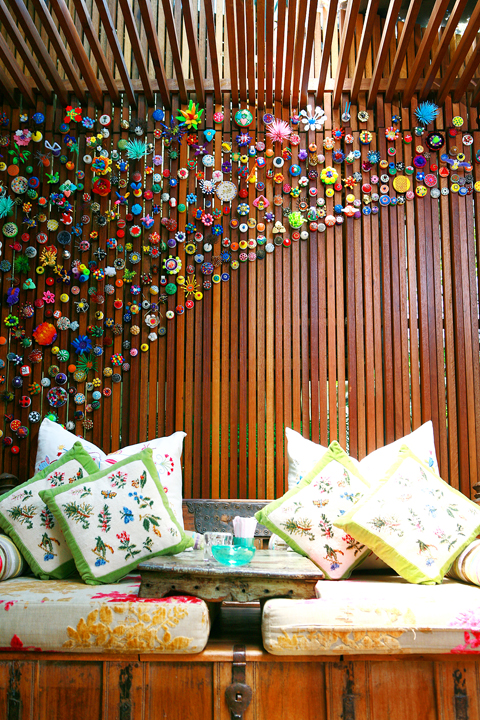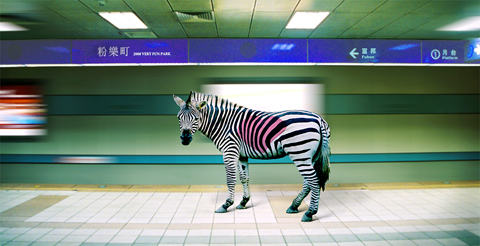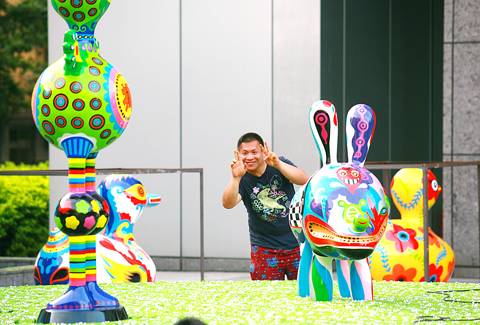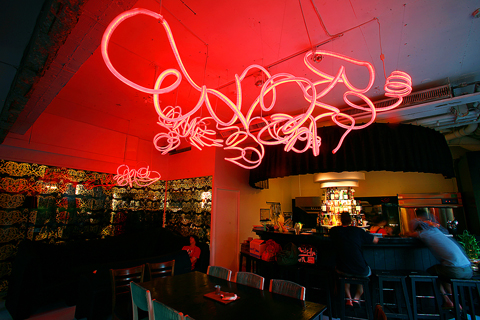The trendsetter restaurants and emporiums of the East District (東區), the Taipei neighborhood surrounding Zhongxiao East Road Section 4 (忠孝東路四段), have new neighbors: more than 40 pieces of art, including a bird’s nest made from silver spoons, floating sculptures made of neon light tubes and a giant slice of wax cake.
Very Fun Park (粉樂町), an outdoor art festival organized by Fubon Art Foundation (富邦藝術基金會), aims to introduce contemporary art into everyday life by encouraging the capital’s inhabitants to wander the winding alleyways behind the area’s main shopping drag for paintings, installation art, toys and video art on display at 30 locations, including clothing, design and toy stores, restaurants, bus stops, a church and an MRT station.
A colossal image of Dongguri, a cheery childlike character created by South Korean artist Kwon Ki-soo (see story above), that adorns Fubon Financial Center’s (富邦金融中心) glass facade encapsulates the festival’s ethos: contemporary art should be fun and should put a big smile on people’s faces.

PHOTO COURTESY OF FUBON ART FOUNDATION
Very Fun Park festival celebrates the East District’s shopping culture. Wang Chung-kun’s (王仲) sound and movement sculpture pays tribute to the silversmiths behind the accessory store Koolook, while Lin Tai-fong’s (林慶芳) traditional Taiwanese playing cards, with their depictions of betel nut girls, glorifies Hot Dog Toyz, a store specializing in capsule toys, action figures and collectables.
Large, bright-colored paper airplanes and boats hanging in the Popmart clothing boutique invite patrons to revisit childhood dreams, while a series of sketches titled Monkey Kids (猴崽) draws a humorous comparison between naughty children and the teenage shoppers at Leftfoot, which sells footwear.
The festival offers an excuse, other than shopping or chowing down, to head over to the East District for a leisurely stroll. For more sedentary art lovers, there are 30 “texicabs” plying the area. These are special taxi cabs bearing the characters kuaile huangbaoche (快樂黃包車), in which passengers can enjoy old Hoklo and Mandarin ballads, write a note on a message board for the next fare, and receive a receipt printed with a happy short story.

PHOTO COURTESY OF FUBON ART FOUNDATION
EXHIBITION NOTES:
WHAT: 2008 Very Fun Park (2008粉樂町)
WHEN: The outdoor art festival runs through Aug. 31;

PHOTO COURTESY OF FUBON ART FOUNDATION
the indoor exhibition at Eslite Bookstore Dunnan Branch
(敦南誠品書店) opens on Aug. 3
WHERE: The area bounded by Dunhua South Road Section 1

PHOTO COURTESY OF FUBON ART FOUNDATION
(敦化南路一段), Zhongxiao East Road, Section 4 (忠孝東路四段),
Civil Boulevard Section 4 (市民大道四段) and Lane 223, Zhongxiao East Road Sec 4 (忠孝東路四段)
ON THE NET: www.fubonart.org.tw/veryfunpark2008/index.html

In the March 9 edition of the Taipei Times a piece by Ninon Godefroy ran with the headine “The quiet, gentle rhythm of Taiwan.” It started with the line “Taiwan is a small, humble place. There is no Eiffel Tower, no pyramids — no singular attraction that draws the world’s attention.” I laughed out loud at that. This was out of no disrespect for the author or the piece, which made some interesting analogies and good points about how both Din Tai Fung’s and Taiwan Semiconductor Manufacturing Co’s (TSMC, 台積電) meticulous attention to detail and quality are not quite up to

April 21 to April 27 Hsieh Er’s (謝娥) political fortunes were rising fast after she got out of jail and joined the Chinese Nationalist Party (KMT) in December 1945. Not only did she hold key positions in various committees, she was elected the only woman on the Taipei City Council and headed to Nanjing in 1946 as the sole Taiwanese female representative to the National Constituent Assembly. With the support of first lady Soong May-ling (宋美齡), she started the Taipei Women’s Association and Taiwan Provincial Women’s Association, where she

Chinese Nationalist Party (KMT) Chairman Eric Chu (朱立倫) hatched a bold plan to charge forward and seize the initiative when he held a protest in front of the Taipei City Prosecutors’ Office. Though risky, because illegal, its success would help tackle at least six problems facing both himself and the KMT. What he did not see coming was Taipei Mayor Chiang Wan-an (將萬安) tripping him up out of the gate. In spite of Chu being the most consequential and successful KMT chairman since the early 2010s — arguably saving the party from financial ruin and restoring its electoral viability —

It is one of the more remarkable facts of Taiwan history that it was never occupied or claimed by any of the numerous kingdoms of southern China — Han or otherwise — that lay just across the water from it. None of their brilliant ministers ever discovered that Taiwan was a “core interest” of the state whose annexation was “inevitable.” As Paul Kua notes in an excellent monograph laying out how the Portuguese gave Taiwan the name “Formosa,” the first Europeans to express an interest in occupying Taiwan were the Spanish. Tonio Andrade in his seminal work, How Taiwan Became Chinese,